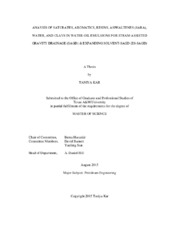| dc.description.abstract | The presence of complex water-in-oil emulsions is a growing concern in heavy oil recovery due to the complexity and expenses involved in separating the water from the produced oil. Hence, it is of paramount importance to understand the components involved in stabilizing these emulsions.
It is well-known that clays and water play a very important role in stabilizing the water-in- oil emulsions by interacting with the heavy molecular-weight polar oil components like asphaltenes and resins. However, a quantitative estimation regarding the role of clays, crude oil components (saturates, aromatics, resins, and asphaltenes) and water in emulsion formation for SAGD has not been illustrated so far. Study of asphaltenes is complicated because of the varying structure, molecular weight, and composition of asphaltenes in different crude oils. Apart from asphaltenes, the common reservoir clays- kaolinite and illite have not been investigated as thoroughly as smectite. Their non-swelling nature causes one to think that their contribution towards reservoir damage would be ignorable. However, while these clays are non-swelling, they can cause formation damage due to their pore lining, pore bridging, and pore cementation features which may increase fluid trapping and consequently, reduce the oil recovery.
Thus, spent rock and residual oil analysis are imperative to understand the pore-scale displacement and wettability alterations occurring in the reservoir during steam injection processes. Wettability alteration studies have not been carried out as extensively for SAGD and ES-SAGD, as compared to other steam injection processes like steam flooding and cyclic steam injection. Moreover, there are limited studies on the impact of clay type on wettability alteration.
This research focuses on the analyses of the types of emulsions formed during SAGD and ES-SAGD, and the effect of clay type and wettability alteration on emulsion formation. While illite travels in the oil phase, kaolinite is found in the water phase, hence, it has been concluded that illite contributes more towards the stable water-in-oil emulsion formation than kaolinite. The use of asphaltene non-solvents during ES-SAGD is recommended to reduce emulsion formation. | en |


